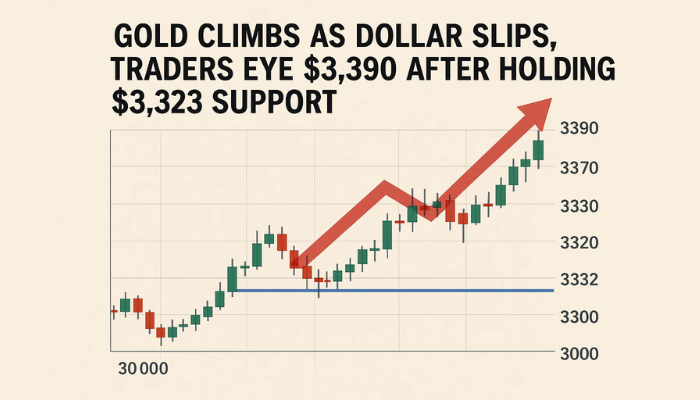Prices Forecast: Technical Analysis
For the daily forecast, Gold is expected to close around $3,342.60, with a potential range between $3,310 and $3,370. The weekly forecast suggests a closing price near $3,350, with a range from $3,300 to $3,380. The RSI at 51.75 indicates a neutral trend, suggesting neither overbought nor oversold conditions. The ATR of 47.33 points to moderate volatility, while the ADX at 11.66 suggests a weak trend. The MACD line above the signal line indicates bullish momentum, but the histogram’s decreasing value suggests weakening momentum. The pivot point at $3,343.47 is crucial, with Gold trading slightly above it, indicating a potential bullish bias. The economic calendar shows stable unemployment rates and retail sales, which may not significantly impact Gold’s price.
Fundamental Overview and Analysis
Gold has recently shown a steady upward trend, reflecting investor confidence amid global economic uncertainties. Factors such as inflation concerns and geopolitical tensions continue to drive demand for Gold as a safe-haven asset. Market participants view Gold as a hedge against currency devaluation and economic instability. Opportunities for Gold’s growth include increased demand from emerging markets and central bank purchases. However, risks such as rising interest rates and a strong US dollar could challenge Gold’s upward trajectory. Currently, Gold appears fairly valued, with its price reflecting both bullish and bearish market sentiments. Investors should monitor economic indicators and geopolitical developments closely, as these will significantly influence Gold’s future performance.
Outlook for Gold
Gold’s future outlook remains cautiously optimistic, with potential for further gains driven by macroeconomic factors. Historical price movements show resilience, with Gold maintaining its value despite market volatility. Key factors influencing Gold’s price include inflation rates, central bank policies, and geopolitical tensions. In the short term (1 to 6 months), Gold is likely to experience moderate gains, with prices potentially reaching $3,400. Long-term forecasts (1 to 5 years) suggest continued growth, supported by sustained demand and limited supply. External factors such as geopolitical conflicts or major economic shifts could significantly impact Gold’s price. Investors should remain vigilant, considering both short-term fluctuations and long-term trends when making investment decisions.
Technical Analysis
Current Price Overview: The current price of Gold is $3,342.60, slightly above the previous close of $3,342.60. Over the last 24 hours, Gold has shown a stable trend with moderate volatility, lacking any significant price spikes or drops. Support and Resistance Levels: Key support levels are at $3,331.93, $3,321.27, and $3,309.73. Resistance levels are at $3,354.13, $3,365.67, and $3,376.33. The pivot point is $3,343.47, with Gold trading just above it, suggesting a potential bullish trend. Technical Indicators Analysis: The RSI at 51.75 indicates a neutral trend. The ATR of 47.33 suggests moderate volatility. The ADX at 11.66 shows a weak trend. The 50-day SMA and 200-day EMA do not show a crossover, indicating no significant trend change. Market Sentiment & Outlook: Sentiment is neutral to slightly bullish, with Gold trading above the pivot and RSI indicating neutrality. The lack of a moving average crossover and moderate ATR suggest stable conditions without extreme volatility.
Forecasting Returns: $1,000 Across Market Conditions
The table below outlines potential returns on a $1,000 investment in Gold under various market scenarios. In a Bullish Breakout scenario, a 10% price increase could raise the investment to approximately $1,100. In a Sideways Range, a 2% fluctuation might result in a value of around $1,020. In a Bearish Dip, a 5% decrease could lower the investment to about $950. These scenarios highlight the importance of understanding market conditions and adjusting investment strategies accordingly. Investors should consider their risk tolerance and market outlook when deciding to invest in Gold. Diversification and regular market analysis can help mitigate risks and optimize returns.
| Scenario | Price Change | Value After 1 Month |
|---|---|---|
| Bullish Breakout | +10% to ~$3,676 | ~$1,100 |
| Sideways Range | +2% to ~$3,409 | ~$1,020 |
| Bearish Dip | -5% to ~$3,175 | ~$950 |
FAQs
What are the predicted price forecasts for the asset?
The daily forecast for Gold suggests a closing price around $3,342.60, with a range between $3,310 and $3,370. The weekly forecast anticipates a closing price near $3,350, with a range from $3,300 to $3,380.
What are the key support and resistance levels for the asset?
Key support levels for Gold are at $3,331.93, $3,321.27, and $3,309.73. Resistance levels are at $3,354.13, $3,365.67, and $3,376.33. The pivot point is $3,343.47, with Gold trading slightly above it.
Disclaimer
In conclusion, while the analysis provides a structured outlook on the asset’s potential price movements, it is essential to remember that financial markets are inherently unpredictable. Conducting thorough research and staying informed about market trends and economic indicators is crucial for making informed investment decisions.



